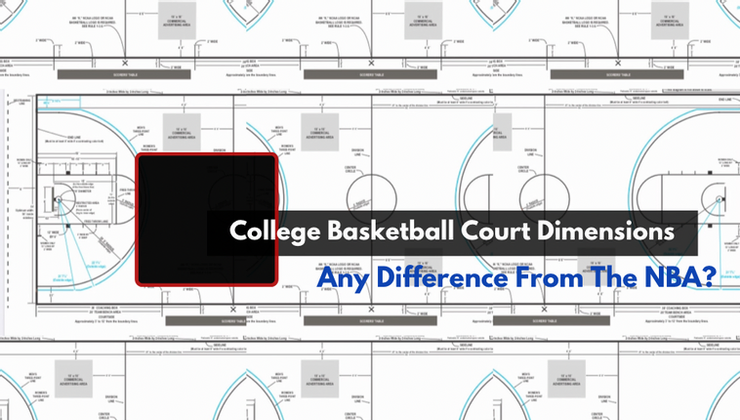The Evolution of the College Basketball Court Size

Nothing has been as controversial as determining the right basketball court size. Over the years, many changes have taken place, all in pursuit of improving the game. The college basketball court size is no exception. But are you familiar with the history behind the various changes in the college basketball court size? Well, I guess not. It is in this light that you might want to take this ride with us. We take a look at some of the basics that you should know about such changes. Read with us!
What is the history of the three-point arc?
Did you know that often, the three-point line tends to come out as the most prominent aspect in a basketball court? It is for this reason that it comes with unmatched history.
This line first came into existence in 1961, 70 years after the invention of the game. It aimed to improve the level of excitement. However, the league chose to push it aside after one and a half years only.
It was not until 1967 that the NBA got a competitor, the ABA. The latter chose to implement the three-point line right from the onset. Fortunately, this move proved to be a huge success. Further to this, it introduced various innovations that attracted many fans. However, these two institutions ended up merging in 1976. But do you know what surprised people the most? The merger did not include the three-point line.
This line was reintroduced in 1979. However, the NCAA held out until 1986 before they finally adopted it. On the other hand, it only became acceptable in high school basketball in 1987.
During the early 90s, this line was moved closer. This move aimed to improve scoring. However, things went back to the original position after three seasons.
Whereas the NBA stuck to the 23 feet, 9 inches distance, NCAA chose to go for 20 feet, 9 inches. It was not until recently that the latter body decided to change. We take a look at these changes as follows.
NCAA chose to move the line back by almost 2 feet.
What changes did the NCAA make to the college basketball court size?
The National Collegiate Athletic Association announced a few changes in the college basketball court dimensions. From 2008, this court has featured a three-point arc at the 20 feet, 9-inch from the center of the basket. However, the NCAA chose to implement the proposal of having 22 feet, 1.75 inches, as the new three-point arc in 2019. Deliberations on moving back the line did not touch on other types of courts. This change would only affect men playing on college courts; a move attracted both criticism and praise in equal measure.
You might want to ask yourself, why did the NCAA choose this new size? Well, most people appreciate having enough space and lines for drive-dribble plays. Setting the three-point arc to 22 feet and 1.75 inches will provide you with this result. Besides that, it would come in handy in offensive spacing. Also, this committee indicated that the move would slow down the rising three-point prevalence in college hoops. However, we cannot fail to mention that the move comes with other effects too, which we will discuss later.
How these changes compare to other basketball court sizes
Undoubtedly, the NCAA and NBA basketball share many similarities. There is hardly any difference in their court, backboard, foul line, tip-off circle, and even the basket height. This way, these aspects will rarely affect your game in the long run. Whereas we appreciate all these similarities, you cannot ignore some vital differences. How about we explore them?
Let us go back to the distance of the three-line arc line. It is the most recognizable difference between the NBA and NCAA basketball courts. The NCAA comes with a 22 feet, 1.75 inches three-line arc while NBA features a 23 feet, 9 inches line. The NCAA’s small size ensures that you get a continuous line from one end of the baseline to the other.
While at it, you will witness that the key is 16 feet wide for the NBA and 12 feet for NCAA. The first box on the side of this key is six feet, unlike 7 in NBA. It would be best if you also remembered that the restricted area under the basket will always be one foot smaller than that of the NBA. Usually, it is three versus four.
Effects of altering the three-point line distance
If we use history as an indicator, then any change on the three-point line will have an impact on the entire system. One of the biggest worries is whether the modification will bring any good to the game. In this light, you can hardly overlook what effect it will have in the long run.
Nothing will feel more pressure than the shooting percentages. Moving the arc back only implies that the rate will go down. On the other hand, players will benefit from an increased opening up of driving lanes as well as post-play. Often, most players tend to shoot with a significant range. For this reason, you will most likely see no difference in the scores. But you might witness much fewer attempts within the region.
You might want to know how this will affect NBA prospects. Well, this move is ideal not only for college but also for those wishing to join the NBA in the future. It will come in handy in preparing the players for the NBA court. While at it, players from high school will get exposure to the international size immediately they join college. Won’t that be great for these players?
In conclusion, we can all agree on how vital the three-point arc is to the basketball court. You can hardly overlook its role in improving the level of excitement within the game. Of course, there will scarcely be an impact on the scores in the long run. That the NCAA decided to move it back is a move that proves beneficial to players from high school, those in college, and NBA prospects.
COLLEGE/NCAA BASKETBALL RELATED ARTICLES:
NCAA Hoops: How Long Is A College Basketball Game?
Does Being An NCAA Basketball Champion Translate Into NBA Success?
Top 5 HBCU Ballers That Became NBA Icons
UNC Men’s Basketball: In 6 Minutes, You’ll Have The Truth About The State Of Their 2020-21 Season









